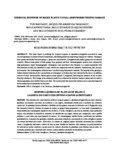Please use this identifier to cite or link to this item:
http://www.alice.cnptia.embrapa.br/alice/handle/doc/1013761| Title: | Chemical response of maize plants with resistance to fall Armyworm feeding damage. |
| Authors: | MACHADO, Y.  TAKAHASHI, J. A.   VIANA, P. A.   RIBEIRO, P. E. de A.   GUIMARAES, P. E. de O.   |
| Affiliation: | YURI MACHADO, UFMG; JACQUELINE APARECIDA TAKAHASHI, UFMG; PAULO AFONSO VIANA, CNPMS; PAULO EDUARDO DE AQUINO RIBEIRO, CNPMS; PAULO EVARISTO DE O GUIMARAES, CNPMS. |
| Date Issued: | 2014 |
| Citation: | Revista Brasileira de Milho e Sorgo, Sete Lagoas, v. 13, n. 3, p. 249-260, 2014. |
| Description: | ABSTRACT: This work aimed at verifying the chemical response to Spodotera frugiperda associated to some selected genotypes resistant to this fall armyworm, subsidizing studies for improving commercial cultivars. Genotypes were grown and divided into two groups: a group was infested with S. frugiperda and another group was not infested (control). Extracts from plants of both groups were prepared and their chromatographic profiles were obtained by high performance liquid chromatography. Chlorogenic acid, described in the literature as a natural metabolite with food deterrent activity, was identified in some extracts by comparison with the authentic standard and, later, by mass spectrometry. The chromatograms obtained were classified using chemometric methods. The majority of the genotypes studied showed reduction in the concentration of chlorogenic acid when they were infested by the insect. In addition, extracts of some infested plants showed good activity against S. frugiperda, indicating the synthesis of one or more bioactive substances. This change in the metabolic profile was evidenced by statistical analysis, where pairs of control infested genotypes were distinct from each other. The results point that interaction between insect and plant impacted on the production of metabolites by the plant. RESUMO - Este trabalho teve como objetivo verificar a resposta química a Spodotera frugiperda associada a diversos genótipos selecionados com fonte de resistência a esta lagarta, subsidiando estudos para a melhoria dos cultivares comerciais. Os genótipos foram cultivados e divididos em dois grupos: uma parcela infestada com S. frugiperda e uma não infestada (controle). Extratos de plantas de ambos os grupos foram preparados e os seus perfis cromatográficos foram obtidos por cromatografia líquida de alta eficiência. O ácido clorogênico, descrito na literatura como metabólito natural com atividade de deterrência alimentar, foi identificado em alguns extratos por comparação com o padrão autêntico e, mais tarde, por espectrometria de massas. Os cromatogramas obtidos foram classificados por métodos quimiométricos. A maioria dos genótipos estudados apresentou redução da concentração de ácido clorogênico quando eles foram infestados pelo inseto. Além disso, os extratos de algumas plantas infestadas mostraram boa atividade contra S. frugiperda, indicando a síntese de uma ou mais substâncias bioativas. Esta mudança no perfil metabólico foi indicada na análise estatística, em que pares de controle infestados de genótipos eram distintos um do outro. Os resultados apontam que a interação entre insetos e planta induziu a produção de metabólitos pela planta. |
| Thesagro: | Spodoptera Frugiperda Zea Mays |
| NAL Thesaurus: | chlorogenic acid |
| Keywords: | HPLC CLAE Ácido clorogênico |
| DOI: | http://dx.doi.org/10.18512/1980-6477/rbms.v13n3p249-260 |
| Type of Material: | Artigo de periódico |
| Access: | openAccess |
| Appears in Collections: | Artigo em periódico indexado (CNPMS)  |
Files in This Item:
| File | Description | Size | Format | |
|---|---|---|---|---|
| Chemicalresponse.pdf | 533,55 kB | Adobe PDF |  View/Open |









